If you’re reading this, you’re likely a bowhunter. If so, ask yourself, “Have I shared my passion for bowhunting with anyone recently?” If not, it’s time to take action – you won’t be alone.
Several prominent outdoor brands – including the Hunting Public, Outdoor Life, Gear Junkie, Mossy Oak, Bowhunter Planet, Wired to Hunt and Bowhunting 360 – agreed to mentor someone new this turkey season, create content around the experience, and post the content using the #LetsHunt hashtag. Each brand hopes to inspire new hunters to start bowhunting and to encourage current hunters (that’s you!) to take someone hunting for the first time. We hope you’ll take part and introduce someone you know to a sport we all love.
Follow these five steps to join the #LetsHunt effort and help a beginner become a bowhunter.

Start the bowhunting conversation with friends and neighbors and see if they’re interested. Photo Credit: ATA
According to an Archery Trade Association survey, only 4% of Americans 18 or older bowhunted in 2015. Meanwhile, a 2019 National Shooting Sports Foundation report found that 84% of Americans approve of hunting for meat. Therefore, it should be easy to find someone curious about hunting. Ask friends, neighbors, coworkers, family and church members if they’re interested – or if they know someone who is.
If you find someone who’s on the fence, tell them why you love to bowhunt and encourage them to read Bowhunting 360’s article “10 Reasons You Should Bowhunt This Year.”
Once you find someone eager to try it out, offer to be their mentor. Learning to bowhunt can be challenging. There’s a lot to learn, which is where a mentor comes in. You can provide tips and hands-on learning experiences.
Most states require you to pass a hunter or bowhunter education course in order to buy a bowhunting license. If you’re like most bowhunters, you probably haven’t given much thought to this course since you passed. However, this is an essential step for a newcomer, as it teaches safety, hunting tactics, hunting laws, shot placement, blood trailing, field care and equipment needs. It’s essentially a ticket to arrowing game animals, obtaining meat and making memories.
Help your mentee enroll in a nearby hunter education class. Some states let students take the course entirely online. Visit your state wildlife agency’s website to learn its requirements and find an option that works well for your rookie.
If they pass the course, help them obtain the proper hunting license. If they can’t pass it in time to hunt turkeys, check to see if your state offers an apprentice hunting license, which is essentially a trial license that allows the holder to hunt without completing a hunter education course as long as a licensed hunter supervises them. Not sure about how it works? Contact your state wildlife agency for guidance.
If that’s not an option, invite them to join you on your adventures to learn through observation. They can still partake in a lot of the experience; they just can’t harvest a bird. Tell them to follow Bowhunting 360’s seven-month plan so they’re ready to bowhunt come fall.

Make sure they practice with the new gear before they go bowhunting. Photo Credit: ATA
Walking into an archery pro shop can be overwhelming, especially for a someone new to the sport. Products line the shelves with flashy packaging that can make them all seem like they’re must-have items. Offer to loan your mentee some camouflage clothing. You can also share your flashlight, game calls, blind, knife and other items during your tandem adventures to save them money. Then, all they need is a bow, a quiver, a release aid, a bow case and some arrows.
Remind them that a bow will be their biggest and most significant purchase, but don’t push them to buy a top-end $1,000 bow unless they’re committed. Encourage them to stick to their budget. There are good ready-to-shoot bow packages, including accessories, for $500 or less. Provide support and reassurance by accompanying them to buy the bow. Pro shop employees are knowledgeable and trustworthy, but your mentee will appreciate having you nearby for advice. Before visiting an archery shop, have them read Bowhunting 360’s article “A Buyer’s Guide to Compound Bows” to learn some tips and terminology. If they want to get other basic gear items, have them read “Bowhunting on a Budget: The Bare Minimum Gear List.”
Regardless of whether your apprentice can harvest a bird or not, they can still practice and scout with you to prepare for a first turkey hunt. Practice is important for all bowhunters (including you!) because it helps them become proficient and ensures their equipment is properly working. Turkey hunters should practice shooting while seated, kneeling or within a ground blind. If they struggle to draw your bow from any of these positions, reduce their draw weight to something manageable. Scouting is necessary to locate birds and pick setup locations.
To further prepare, help them learn the turkey’s vital areas, practice their turkey calls and research decoy strategies. These articles can help:

Be patient with young bowhunters: They want to learn from you. Photo Credit: ATA
When opening day rolls around, head afield, but don’t set your expectations too high. Hunting with a beginner (either a child or an adult) has its challenges. Be patient. They’re learning what to do – and what not to do. Stay calm if they slam the truck door, talk too loudly, fidget at the wrong moment or accidentally blow the hunt. Use each mistake as a teachable moment and give them tips and advice in a friendly tone that’s not condescending. Don’t forget to answer their questions and model how to be an ethical bowhunter. All of your efforts will pay off when you (or they) arrow a bird – or at least get close!
If your mentee enjoyed the hunt or the process, encourage them to stick with it. Offer your assistance if they need help or have questions as they prepare to bowhunt deer come fall.
Be sure to post your bowhunting photos, stories and adventures to social media using the #LetsHunt hashtag. Encourage your friends and followers to get involved and take someone bowhunting, too. The more people we have welcoming newcomers to our sport, the better. Together we can create a stronger, more unified bowhunting community.